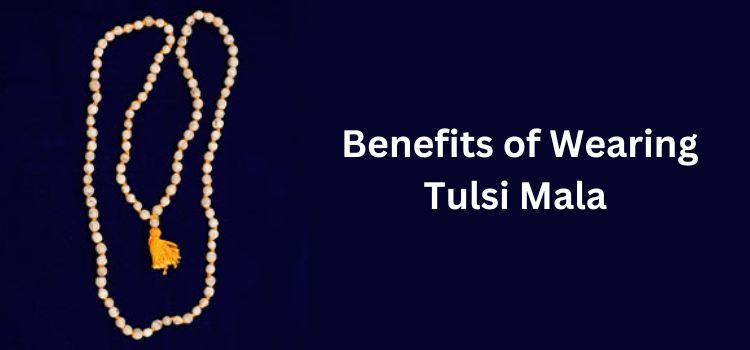Tulsi, or holy basil, is a very holy plant for Hindus. The plant is worshipped as Goddess Tulsi. Tulsi plants can be seen in most Hindu homes, and it is the custom for women to pray to her in the morning after their bath.
Many feel it is auspicious to plant Tulsi in the house’s Brahmasthan. It is said to emit divinity into the atmosphere and also positive energy. Brahmasthan is the most sacred point in the house and is also the precise center of the house. Tulsi is renowned for its healing properties. Tulsi beads are also used to make ‘malas,’ or rosaries which can be worn or used for chanting Mantras.
While Hindus wear white beaded Tulsi mala, Buddhists usually wear the black Tulsi mala, which is the favorite of Vishnu’ and Krishna devotees. It’s used for meditation and Mantra chanting. Tulsi beads have a therapeutic effect. They can purify the mind and soul.
Hindus worship Tulsi for the well-being of their families. It is better to avoid garlic, onion, and non-vegetarian items when wearing a Tulsi mala.

Tulsi mala can be used as an ornament as well as a rosary or japamala. The japamala has 108 beads plus one. People often chant a Mantra 108 times, or 108 names of a God, so the japamala has 108 beads. The extra bead is to prevent the person performing the sadhana from becoming dizzy. The Krishna bead in the mala is slightly larger than the others. One should begin chanting the Mantras on one side of the mala, and after covering all 108 beads, one should not cross over the Krishna bead but begin the next round on the opposite side.
Tulsi Mala’s Benefits
The Garuda Purana talks about the many benefits of the Tulsi Mala. Tulsi is very dear to Vishnu and Krishna. Vishnu, says the Garuda Purana, lives with those who wear Tulsi beads. It adds that the advantages of wearing it are a million times more than those gained from ritual worship, Pitra Puja, or other good deeds. It can protect one from nightmares, fear, weapons, and accidents. Even the representatives of Yama, the God of Death, keep a safe distance from such people. It also wards off threats from ghosts and black magic.
Tulsi beads supposedly have the power to purify our mind, body, and spirit. It gives positive vibrations to our aura and helps remove bad energy. Wearing a Tulsi mala can give better concentration and enable us to overcome diseases. The wood used to make the beads is good for the skin. The Skanda Purana claims that it can cleanse the worst sins. Vishnu, in the Vishnu Dharmaottara, states that those who wear a Tulsi mala can attain him, even if the person has a sinful or terrible character.
When one wears a Tulsi garland, the mind and body will be in sync. This will put pressure on the body’s major acupressure points, which reduces mental tension. It can enhance the flow of electricity through the body. On account of the emission of electromagnetic waves, blood circulation also improves.
Tulsi is a good material for Mala beads, as it brings purity and lightness. It can also restore balance and harmony to the body, as per Ayurveda. As Tulsi Mala beads are small and light, they are easy to use and carry.
The Mala brings a sense of calm and good health into the wearer’s life. It helps maintain spiritual purity and repels evil spirits. Tulsi is used in the worship of Vishnu, Krishna, and Balarama. It is good for throat ailments, according to Ayurveda. By purifying the body, it keeps diseases away. Also, it can make the mind calm and peaceful.
It helps one to avoid kidney problems.
It has the ability to remove toxins from the nerves by reducing blood cholesterol and blood pressure.
Guidelines to Wear Tulsi Mala
Present the Tulsi mala to Vishnu first before wearing it. After that, clean the mala with Pancha Gavya before chanting the ‘moola-mantra.’ Recite the Gayatri Mantra 8 times next. After this, chant the Sadyojata Mantra. After all these steps, chant the Mantra to thank Goddess Tulsi and request her to bring you closer to Vishnu. Do not wear the mala over the neck. Padma Purana supposedly has laws saying that it should be worn at all times, even during morning ablutions and that it should not be removed during bathing, eating, etc.


Нужно найти информацию о пользователе? Наш сервис предоставит детальный отчет мгновенно.
Используйте продвинутые инструменты для анализа публичных записей в соцсетях .
Выясните место работы или интересы через автоматизированный скан с верификацией результатов.
как установить глаз бога в телеграм
Система функционирует с соблюдением GDPR, используя только открытые данные .
Получите детализированную выжимку с геолокационными метками и графиками активности .
Доверьтесь надежному помощнику для исследований — результаты вас удивят !
Patek Philippe — это pinnacle механического мастерства, где соединяются прецизионность и художественная отделка.
С историей, уходящей в XIX век компания славится авторским контролем каждого изделия, требующей сотен часов .
Инновации, такие как автоматические калибры, укрепили репутацию как новатора в индустрии.
Часы Патек Филипп купить
Лимитированные серии демонстрируют вечные календари и ручную гравировку , подчеркивая статус .
Текущие линейки сочетают инновационные материалы, сохраняя механическую точность.
Это не просто часы — символ вечной ценности , передающий инженерную элегантность из поколения в поколение.
Перевозка товаров из КНР в РФ проводится через железнодорожные маршруты , с проверкой документов на в портах назначения.
Таможенные пошлины составляют от 5% до 30% , в зависимости от категории товаров — например, готовые изделия облагаются по максимальной ставке.
Чтобы сократить сроки используют серые каналы доставки , которые избегают бюрократических задержек, но связаны с дополнительными затратами.
Доставка грузов из Китая
При официальном оформлении требуется предоставить сертификаты соответствия и акты инспекции, особенно для сложных грузов .
Сроки доставки варьируются от одной недели до двух недель , в зависимости от удалённости пункта назначения и загруженности контрольных пунктов.
Стоимость услуг включает логистику , налоги и услуги экспедитора, что требует предварительного расчёта .
For years, I assumed medicine was straightforward. Doctors give you pills — you nod, take it, and move on. It felt safe. But that illusion broke slowly.
Then the strange fog. I blamed my job. But my body was whispering something else. I searched forums. The warnings were there — just buried in jargon.
cenforce 150
That’s when I understood: your body isn’t a template. Two people can take the same pill and walk away with different futures. Side effects hide. Still we don’t ask why.
Now I question more. But because no one knows my body better than I do. I challenge assumptions. But I don’t care. This is survival, not stubbornness. The turning point, it would be keyword.
Эта платформа предлагает важные инфосообщения в одном месте.
Здесь можно найти факты и мнения, бизнесе и разных направлениях.
Информация обновляется почти без перерывов, что позволяет следить за происходящим.
Понятная навигация ускоряет поиск.
https://modastars.ru
Все публикации предлагаются с фактчеком.
Целью сайта является честной подачи.
Читайте нас регулярно, чтобы быть в курсе самых главных событий.
Rolex Submariner, выпущенная в 1954 году стала первой дайверской моделью, выдерживающими глубину до 100 метров .
Модель имеет 60-минутную шкалу, Triplock-заводную головку, обеспечивающие безопасность даже в экстремальных условиях.
Дизайн включает хромалитовый циферблат , стальной корпус Oystersteel, подчеркивающие функциональность .
Хронометры Ролекс Субмаринер цены
Автоподзавод до 70 часов сочетается с перманентной работой, что делает их надежным спутником для активного образа жизни.
За десятилетия Submariner стал символом часового искусства, оцениваемым как коллекционеры .
La montre connectée Garmin fēnix® Chronos incarne l’excellence horlogère avec des matériaux premium comme le titane Grade-5 et fonctionnalités GPS intégrées .
Conçue pour les sportifs , elle allie robustesse et autonomie prolongée , idéale pour les aventures en extérieur grâce à ses outils de navigation .
Grâce à son autonomie allant jusqu’à 6 heures , cette montre reste opérationnelle dans des conditions extrêmes, même lors de activités exigeantes.
https://garmin-boutique.com/fenix-5
Les outils de suivi incluent la surveillance du sommeil , accompagnées de conseils d’entraînement personnalisés, pour les amateurs de fitness .
Intuitive à utiliser, elle s’intègre à votre quotidien , avec une interface tactile réactive et synchronisation sans fil.
La montre connectée Garmin fēnix® Chronos représente un summum de luxe avec des finitions raffinées et capteurs multisports.
Conçue pour les sportifs , elle propose une polyvalence et durabilité extrême, idéale pour les aventures en extérieur grâce à ses outils de navigation .
Avec une batterie allant jusqu’à plusieurs jours selon l’usage, cette montre s’impose comme une solution fiable , même lors de sessions prolongées .
garmin venu
Les fonctions de santé incluent la fréquence cardiaque en temps réel , accompagnées de conseils d’entraînement personnalisés, pour les utilisateurs exigeants.
Facile à personnaliser , elle s’intègre à votre quotidien , avec un écran AMOLED lumineux et synchronisation sans fil.